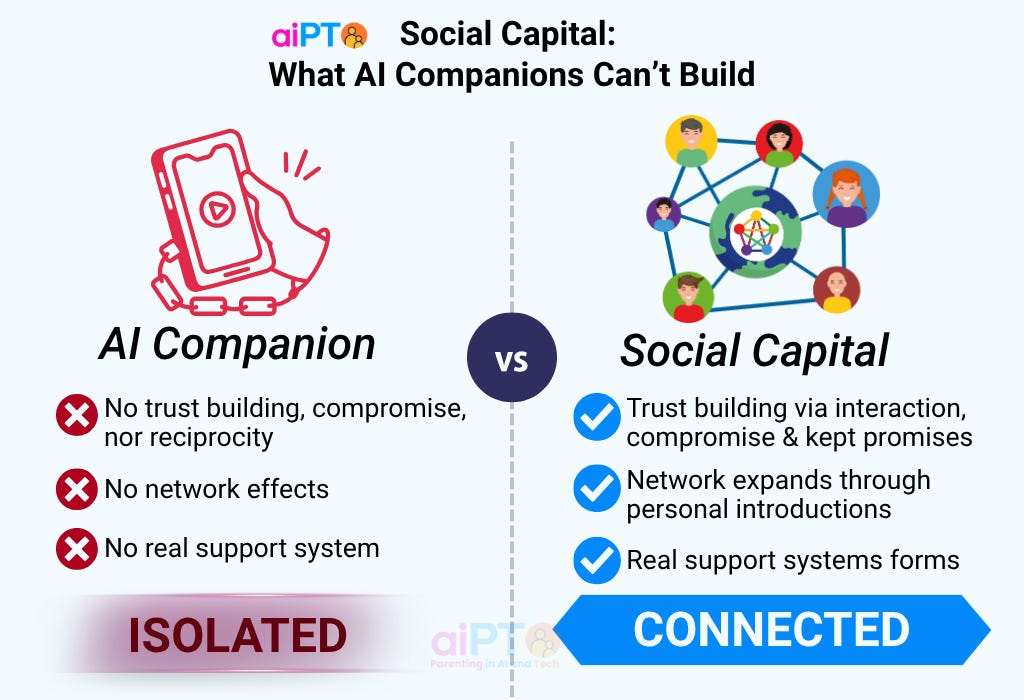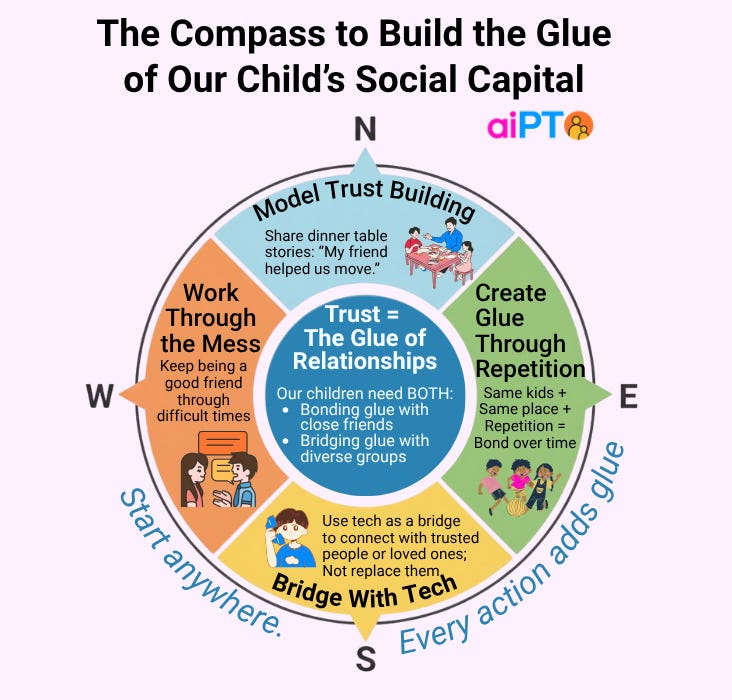Can We Help Our Kids Build Real Friendships in the Age of AI Companions?
Why Trust Is the Glue of Friendship—And How Parents Can Help Kids Build It
Loneliness Epidemic and the Rise of AI Companions
When I arrived in the US a decade ago, I moved alone to a new country with just three suitcases.
Going from the top of my class in Indonesia to feeling average at an Ivy League school, I struggled with intense imposter syndrome.
Even as someone who worked across multiple countries, I somehow struggled to make friends and lost confidence.
Just like me. Everyone has felt loneliness at some point of their lives.
But not at the rate and age that our teens face today. 1 in 6 teenagers worldwide experience loneliness, with 25% of youth feeling fairly or very lonely. 1 2
And now we’re seeing something unprecedented: teens forming intense emotional bonds with AI companion with tragic consequences.
As a parent, here’s what I’m concerned about: our children aren’t just facing loneliness in the world of screens and AI. They’re losing the ability to build the very thing that protects against loneliness: social capital.
Social capital is what Harvard Professor and Political Scientist Robert Putnam describes as the invisible bonds of trust and mutual support that hold relationships together.3
Trust is the currency that builds this social capital and it works like superglue.
It’s your child’s support system: who they can call for help, who shares opportunities with them, and who makes them feel included.
It’s the difference between having 2,000 followers on social media versus having someone to call at 2am when they’re struggling.
Never before do we have an urgency for our children and teens to find meaningful and healthy connections with one another.

And, the big tech industry’s solution? AI Companions.
The market grew rapidly, from $26 billion in 2023 to $32 billion in 2024, with millions of young users on platforms like Character.AI, Replika, and Snapchat’s My AI. 4 5
AI Companion Rise As Social Capital Declines
The reality is today’s AI companions can’t build social capital for our kids.
AI companions cannot introduce your child to a real friend they can depend on. It doesn’t create real communities or support systems.
It’s ironic that the tech aiming to solve loneliness may instead deepen social isolation.
Because most AI companions treat the surface symptoms of loneliness and never get to the root cause.
So, users “feel” heard and less lonely in the moment.
But over time, these digital comforts can lead kids to withdraw from social interaction and grow dependency on the companion itself.
To be fair, AI companions have helped some adults, particularly those dealing with social anxiety, therapy waitlists, or acute isolation. Research found 63% of adult student users of Replika reported reduced feelings of loneliness or anxiety.6
But children are different.
Adults using AI typically already have established social skills and real support systems. Most are supplementing, not replacing, human connection.
For kids still learning to trust, navigate conflict, and build reciprocal relationships, the risk is fundamentally different.
As Stanford psychiatrist Dr. Nina Vasan explains, AI companions offer “frictionless relationships without the rough spots bound to come up in typical friendship. For adolescents still learning how to form healthy relationships, these systems can reinforce distorted views of intimacy.”7
If an AI companion becomes a child’s primary emotional support, it short-circuits the very skills kids need most to build trust, friendship, and social support.
Trust is the Currency of Meaningful Relationships That Our Kids Need to Master
The digital world where many kids grow up today has transformed, if not erode, networks of trust, relational depth, and long-term connections.
This is important because, as confirmed by WHO, social connection (and thus network of trust) is linked to health and longevity, and this crucial link is at risk in our digital societies.8
Let me paint you a contrast.
Many of us still remember the pre-internet era, where trust was built over time in close and face-to-face interactions with friends, family, and neighbors.
I knew my neighbor, my neighbor’s kid who goes to the same school, the cafeteria workers, and even my parents’ coworkers’ kids.
With social media, our kids can connect with a beauty blogger traveling across the world or a rocket scientist, like Emily Calandrelli, instantly and effortlessly.
But not all connections build trust and support systems.
Today’s social media environment filters and fragments interaction, shifting trust towards transactional, partial views.
There’s a veil between people online where you can’t see what’s behind the screen, making it easier to judge, mock, and hide.
This online anonymity and perceived distance distort social norms, reduce safe spaces for authentic openness, and hinder deep trust development.
Unfortunately, this is what most kids experience online.
So it is understandable why some might open up more to AI companions. They are perceived to be safe, non-judgmental, even if they’re just programmed to reaffirm or agree.
But our kids and teens may not be aware of the costs of relying on AI companions: depriving themselves of relational growth and emotional complexity. As importantly, the ability to build their own social support.
Which raises an important question: Will our children’s confidence in real relationships suffer if much of their support comes from apps?
As parents, our job isn’t to shield kids from every uncomfortable social moment—it’s to help them develop the skills to navigate real relationships.
Here’s how trust works like superglue for social capital:
Each kept promise strengthens the bond. Each act of helping creates stickiness. Each time you work through conflict together, the glue becomes stronger.
This is what our kids need to learn and what AI companions can’t teach.
When dealing with AI companions, there’s no effort to strengthen bonds, no promises that matter, no conflicts that make the relationship stronger. Just the illusion of connection.
So, how do we help our kids build this glue in a world that increasingly offers frictionless alternatives?
Four Ways To Strengthen Human to Human Approach
Based on both research and my own journey, here are a few ways we can support our kids’ real connections to fellow humans, even as AI companions spread fast.
1. Model Trust Building and Show Them What Social Capital Looks Like
Because kids learn by example and not telling, we need to model how we create and maintain our support systems.
I want my kids to be able to identify trustworthy people, build trust, and know when to give them. In my home, this looks like:
Sharing friendship stories at dinner: “Remember when my friend, Aunt W, and her husband, helped us move? That’s what friendship looks like. We need to show up when others need help.”
Narrating my trust decisions out loud: “My friend and I trained intensely for an international competition for months at a time. We can just confer around 10 minutes before each debate and nailed our debates. We were in such lockstep and trust each other.”
Acknowledging when my daughter keeps her word: This is her first year of having any homework. So when she completed her homework without any prompting, I commend her.
Here’s a conversation you can have with them:
“Trust is earned and not given. But here’s the thing, someone has to go first. That involves the most basic premise: BE a trustworthy person and know who to spot another. Making friends are the same. We have to be a good friend first and know how find good friends.”
2. Facilitate Low-Stakes IRL Interactions Through Repetition
Our goal should be to encourage them to build resilience, empathy, and social skills through repeated proximity or IRL interactions.
Research shows that physical proximity matters enormously. In fact, simply being seated next to each other increased the probability of mutual friendship from 15% to 22%.9
There are many simple ways to create this repeated IRL interaction.
In practice, I do this with my kids:
Monthly get together with the same 2-3 classmates.
Weekly play time in the neighborhood playground. Sometimes with familiar, sometimes new kids.
One-on-one playdates with certain people
For older kids, taking an active role in volunteering or sports activity naturally foster social networks.
We need our kids to have both “bonding capital” (deep connections with similar friends) and “bridging capital” (diverse connections across different groups).10
3. Use Tech as Bridges to Real and Trusted People, Not a Replacement
Not all digital connection is bad.
As a parent living halfway across the globe from my own parents, technology enables my kids video call their grandparents weekly. It maintains their bond that would otherwise fade.
Here’s the examples I teach my kids on how tech can be bridge to connect with trusted people:
Video calling family members or loved ones who live far away;
Group chats to coordinate real-world hangouts;
Using apps to plan actual IRL activities together;
If you have an older child or teenager who might have their own device, here’s a conversation starter to evaluate together:
“Let’s look at your screen time together. Which apps help you connect with people you know in real life? Which ones are just... filling time? What would you want to shift?”
“Tech should add to your real friendships, not replace them. If you’re spending more time talking to AI or watching strangers online than with friends or family who actually know you, we need to rebalance.”
4. Help Them to Embrace Messy, Imperfect Friendship: Where Trust Is Built
Research shows that when conflict happens among friends, they’re more likely to try to negotiate, compromise, and continue playing compared to non-friends. So, working through conflict actually strengthens social capital.11
Helping kids tolerate the discomfort of real human relationships is one of parent’s most important jobs.
When my daughter wasn’t invited to a birthday party, here’s what we talked about: “I know it stings. Let’s think through possibilities together: Maybe it’s a small or a family-only thing. Maybe she’s closer to other friends right now. And that’s okay. Focus on what you can control: Continue being kind and yourself, and still play with her as usual. Real friendships can survive these moments.”
When daily relationships get messy, try this: “You got mad at your brother because of a misunderstanding. This is uncomfortable, but it’s also fixable. You can talk to him about what happened. Say ‘Hey, I think we misunderstood each other. Can we talk?’ This is how trust grows. Working through hard moments even when it’s uncomfortable.”
The Art of Human Connection in the AI Era
While trust building has transformed since pre-internet days, we should still help our kids understand the foundation of human connection, which often still starts with authenticity and sincerity.
As a humanist who works in tech, I believe modern technologies need to prioritize meaningful human connection over the convenience of transactional connection.
AI chatbots and tools should be designed to encourage users to meaningfully connect with others. Think: group chats that facilitate in person activities, reminders to pause or reach out to a trusted real person, like parents, therapist, or local support networks.
We as parents can still be active guides in our kids’ development in social capital and trust building.
The evidence is clear: the networks of trust and support we help our children build today will shape their health, happiness and resilience for a lifetime.
Let me leave you with a question: What’s the one thing you’ll do differently this month to help your child build real social capital?
- Dhani





